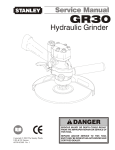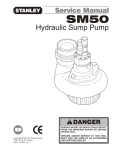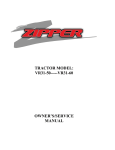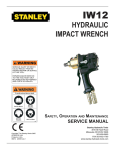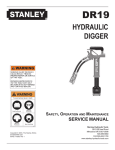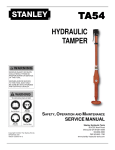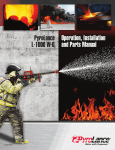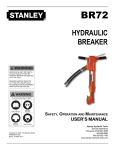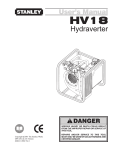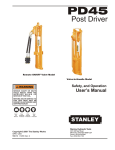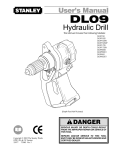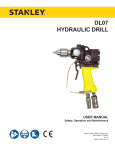Download Service Manual ID07
Transcript
® Service Manual ID07 Impact Drill/ Wrench DANGER SERIOUS INJURY OR DEATH COULD RESULT FROM THE IMPROPER REPAIR OR SERVICE OF THIS TOOL. Copyright c 2003 The Stanley Works USA & CE Version 60788 7/2003 Ver. 1 REPAIRS AND/OR SERVICE TO THIS TOOL MUST ONLY BE DONE BY AN AUTHORIZED AND CERTIFIED DEALER. Table of Contents ID07 Impact Drill/ Wrench SERVICING THE ID07 IMPACT DRILL/WRENCH: This manual contains Safety, Operation, and Troubleshooting information. Stanley Hydraulic Tools recommends that servicing of hydraulic tools, other than routine maintenance, must be performed by an authorized and certified dealer. Please read the DANGER warning on the cover and the SAFETY warning below. Copyright c 2003 The Stanley Works All rights reserved. Certificate of Conformity 3 Specifications 4 General Safety Instructions 5 Tool Decals and Tags 6 Hydraulic Hose Requirements 7 HTMA Requirements 8 Operating Instructions 9 Service Instructions 12 Troubleshooting 15 Parts Illustration 16 Parts List 17 Accessories 19 Warranty 20 SAFETY FIRST Under copyright law, this document may not be copied in whole or in part without the prior written consent of The Stanley Works. This exception does not permit copies to be made for others, whether or not sold. Under the law, copying includes translating into another language, format or medium. This copyright notice must appear on any permitted copies. It is the responsibility of the operator and service technician to read rules and instructions for safe and proper operation and maintenance. A cautious worker using common sense is the greatest safety device. 2 Certificate of Conformity CERTIFICATE OF CONFORMITY ÜBEREINSTIMMUNGS-ZERTIFIKAT CERTIFICAT DE CONFORMITE CEE CERTIFICADO DE CONFORMIDAD CERTIFICATO DI CONFORMITA Hydraulic Tools I, the undersigned: Ich, der Unterzeichnende: Je soussigné: El abajo firmante: lo sottoscritto: Burrows, James Surname and First names/Familiennname und Vemamen/Nom et prénoms/Nombre y apellido/Cognome e nome hereby certify that the construction plant or equipment specified hereunder: bestätigt hiermit, daß die Konstruktion und Ausrüstung wie folgt spezifiziert ist: atteste que le brise-béton: por el presente certifico que la fabrica o el equipo especificado a continuacion: certifico che l’impianto o l’attrezzatura sotto specificata: 1. Category: Impact Drills Kategorie: Catégorie: Categoria: Categoria: 2. Make/Ausführung/Marque/Marca/Fabbricazion: Stanley 3. Type/Typ/Type/Tipo/Tipo: ID0781001, ID0782001 4. Type serial number of equipment: Typ und Serien - Nr. der Ausrüstung: Numéro dans la série du type de matériel: Numero de serie tipo del equipo: Matricola dell´attrezzatura: ALL 5. Year of manufacture/Baujahr/année de fabrication/Año de fabricacion/Anno di fabbricazione: 2003 has been manufactured in conformity with - EEC Type examination as shown. wurde hergestellt in Übereinstimmung mit - EEC Typ-Prüfung nach. est fabriqué conformément - au(x) type(s) examiné(s) comme indiqué dans le tableau di-après. ha sido fabricado de acuerdo con - tipo examen EEC como dice. è stata costruita in conformitá con - le norme CEE come illustrato. Directive Richtlinie Directives particulières Directriz Direttiva No. Nr Numéro No n. Date Datum Date Fecha Data Approved body Prüfung durch Organisme agréé Aprobado Collaudato Date of expiry Ablauf datum Date d´expiration Fecha de caducidad Data di scadenza EN EN ISO EN 792-6 3744 28662-7 1994 1995 1997 Self Self Self NA NA NA 6. Special Provisions: None Spezielle Bestimmungen: Dispositions particulières: Provisiones especiales: Misure special: Sound Level: 108 dBA Vibration Level: 2.0 m/s2 Done at/Ort/Fait à/Dado en/Fatto a Stanley Hydraulic Tools, Milwaukie, Oregon USA Date/Datum/le/Fecha/Data 6/16/03 Signature/Unterschrift/Signature/Firma/Firma Position/Position/Fonction/Puesto/Posizione Engineering Manager 3 Specifications Drive Size__________1/2 in. square or 7/16 in. hex Pressure Range___________ 2000 psi / 140 bar Flow Range_____________4-12 gpm / 15-45 lpm Optimum Flow____________4-9 gpm / 15-34 lpm Porting_______________________-8 SAE O-ring Connect Size & Type___ 3/8 in. NPT Pipe Fitting Weight (less couplers)__________7.2 lbs. / 3.3 kg Overall Length________________ 9 in. / 22.9 cm Width______________________ 4.5 in. / 11.4 cm Height_____________________ 10.5 in. / 26.7 cm Motor____________________________ Integral Outport Torque_____________500 ft lbs / 675 Nm Max. Fluid Temp._____________ 140° F / 60° C HTMA Class I ____________4-6 gpm @ 2000 psi EHTMA Category______20 lpm @ 138 bar HTMA Class II___________7-9 gpm @ 2000 psi 30Lpm at 138bar BHTMA CATEGORY EHTMA Category_____30 lpm @ 138 bar Sound Power Level_______________104.5 dBA Vibration Level_____________________6.4 m / s2 4 General Safety Instructions Always observe safety symbols. They are included for your safety and the protection of the tool. WARNING DANGER This safety symbol may appear on the tool. It is used to alert the operator of an action that could place him/her or others in a life threatening situation. This safety symbol appears in these instructions to identify an action that could cause bodily injury to the operator or other personnel. CAUTION This safety symbol appears in these instructions to identify an action or condition that could result in damage to the tool or other equipment. This tool will provide safe and dependable service if operated in accordance with the instructions given in this manual. Read and understand this manual and any stickers and tags attached to the tool and hoses before operation. Failure to do so could result in personal injury or equipment damage. h Operator must start in a work area without bystanders. The operator must be familiar with all prohibited work areas such as excessive slopes and dangerous terrain conditions. h Establish a training program for all operators to ensure safe operations. h Do not operate the tool unless thoroughly trained or under the supervision of an instructor. h Always wear safety equipment such as goggles, head protection, and safety shoes at all times when operating the tool. h Do not inspect or clean the tool while the hydraulic power source is connected. Accidental engagement of the tool can cause serious injury. h Do not operate this tool without first reading the Operating Instructions. h Do not install or remove this tool while the hydraulic power source is connected. Accidental engagement of the tool can cause serious injury. h Never operate the tool if you cannot be sure that underground utilities are not present. Underground electrical utilities present an electrocution hazard. Underground gas utilities present an explosion hazard. Other underground utilities may present other hazards. h Do not operate in a potentially explosive atmosphere. h Do not wear loose fitting clothing when operating the tool. Loose fitting clothing can get entangled with the tool and cause serious injury. h Supply hoses must have a minimum working pressure rating of 2500 psi/175 bar. h Be sure all hose connections are tight. h The hydraulic circuit control valve must be in the “OFF” position when coupling or uncoupling the tool. Wipe all couplers clean before connecting. Failure to do so may result in damage to the quick couplers and cause overheating. Use only lint-free cloths. h Do not operate the tool at oil temperatures above 140° F/60° C. Operation at higher oil temperatures can cause operator discomfort and may cause damage to the tool. h Do not operate a damaged, improperly adjusted, or incompletely assembled tool. h To avoid personal injury or equipment damage, all tool repair, maintenance and service must only be performed by authorized and properly trained personnel. h Do not exceed the rated limits of the tool or use the tool for applications beyond its design capacity. h Always keep critical tool markings, such as labels and warning stickers legible. h Always replace parts with replacement parts recommended by Stanley Hydraulic Tools. 5 Tool Decals & Tags A Name Tag Sticker is attached to the tool. Never exceed the flow and pressure levels specified on this sticker.The information listed on the name tag sticker must be legible at all times. Replace this sticker if it becomes worn or damaged. A replacement is available from your local Stanley distributor. 28323 28788 “CE” Decal Manual Sticker WARNING Correctly connect hoses to tool ports. Do not exceed specified flow or pressure. Improper handling, use or maintenance can cause a leak or burst that can result in oil injection to the body. Failure to observe these precautions may result in serious personal injury. 29149 Rotation Direction Sticker 58862 Pressure Warning Sticker LWA 30Lpm at 138bar BHTMA CATEGORY 108 29530 Sound Power Sticker 11207 Circuit Type “D” Decal WARNING Read owners manual and ensure that youPhave been properly trained to work on orParound electric lines. Failure to use hydraulicPhose labeled and certified as non-conductivePmay result in death or serious personal injury. Stanley Hydraulic Tools R Model No. Id07 3810 SE Naef Rd Milwaukie, Oregon 97267 U.S.A. 58864 Electrical Warning Sticker 15-46 lpm/4-12 gpm 140 bar/2000 psi 60806 ID07 Model Sticker OC/CC FOR USE ON OPEN CENTER AND CLOSED CENTER HYDRAULIC SYSTEMS, "SET FOR PROPER SYSTEM BEFORE USE" 11354 OC/CC Sticker DANGER 1. FAILURE TO USE HYDRAULIC HOSE LABELED AND CERTI-FIED AS NON-CONDUCTIVE WHEN USING HYDRAULIC TOOLS ON OR NEAR ELECTRICAL LINES MAY RESULT IN DEATH OR SERIOUS INJURY. BEFORE USING HOSE LABELED AND CERTIFIED AS NON- CONDUCTIVE ON OR NEAR ELECTRIC LINES. BE SURE THE HOSE IS MAINTAINED AS NON- CONDUCT IVE . THE HOSE SHOULD BE REGULARLY TESTED FOR ELECTRIC CURRENT LEAKAGE IN ACCORDANCE WITH YOUR SAFETY DEPARTMENT INSTRUCTIONS. 2. A HYDRAULIC LEAK OR BURST MAY CAUSE OIL INJECTION INTO THE BODY OR CAUSE OTHER SEVERE PERSONAL INJURY. A.DO NOT EXCEED SPECIFIED FLOW AND PRESSURE FOR THIS TOOL. EXCESS FLOW OR PRESSURE MAY CAUSE A LEAK OR BURST. B. DO NOT EXCEED RATED WORKING PRESSURE OF HYDRAULIC HOSE USED WITH THIS TOOL. EXCESS PRESSURE MAY CAUSE A LEAK OR BURST. C. C H E C K T O O L , H O S E , C O U P L E R S & C O N N E C T O R S D A I L Y F O R LEAKS. DO NOT FEEL FOR LEAKS WITH YOUR HANDS. CONTACT WITH A LEAK MAY RESULT IN SEVERE PERSONAL INJURY. * Not all stickers are furnished on all tool models. Consult parts list and model number for details. The SAFETY TAG, P/N 15875, shown at right, smaller than actual size, is attached to the tool when shipped from the factory. Read and understand the safety instructions listed on this tag before removal. We suggest you retain this tag and attach it to the tool when not in use. 6 DANGER D. DO NOT LIFT OR CARRY TOOL BY THE HOSES. DO NOT ABUSE HOSE. DO NOT USE KINKED, TORN OR DAMAGED HOSES. 3. MAKE SURE HYDRAULIC HOSES ARE PROPERLY CONN-ECTED TO THE TOOL BEFORE PRESSURIZING SYSTEM. SYSTEM PRESSURE HOSE MUST ALWAYS BE CONNECTED TO TOOL “IN” PORT. SYSTEM RETURN HOSE MUST ALWAYS BE CONNECTED AT TOOL “OUT” PORT. REVERSING CONNECTIONS MAY CAUSE REVERSE TOOL OPERATION WHICH CAN CAUSE SEVERE PERSONAL INJURY. 4. DO NOT CONNECT CLOSED-CENTER TOOLS TO OPEN-CENTER HYDRAULIC SYSTEMS. THIS MAY CAUSE EXTREME SYSTEM HEAT AND/OR SEVERE PERSONAL INJURY. DO NOT CONNECT OPEN-CENTER TOOLS TO CLO SE D- CE NT ER HYDRAULIC SYSTEMS. THIS MAY RESULT IN LOSS OF OTHER HYDRAULIC FUNCTIONS POWERED BY THE SAME SYSTEM AND/OR SEVERE PERSONAL INJURY. 5. BYSTANDERS MAY BE INJURED IN YOUR WORK AREA. KEEP BYSTANDERS CLEAR OF YOUR WORK AREA. 6. WEAR HEARING, EYE, FOOT, HAND AND HEAD PROTECTION. 7. TO AVOID PERSONAL INJURY OR EQUIPMENT DAMAGE, ALL TOOL REPAIR, MAINTENANCE AND SERVICE MUST BE PERFORMED BY AUTHORIZED AN D PR OP ER LY TRAINED PERSONNEL. IMPORTANT IMPORTANT READ OPERATION MANUAL AND SAFETY INSTRUCTIONS FOR THIS TOOL BEFORE USING IT. READ OPERATION MANUAL AND SAFETY INSTRUCTIONS FOR THIS TOOL BEFORE USING IT. USE ONLY PARTS AND REPAIR PROCEDURES APPROVED BY STANLEY AND DESCRIBED IN THE OPERATION MANUAL. USE ONLY PARTS AND REPAIR PROCEDURES APPROVED BY STANLEY AND DESCRIBED IN THE OPERATION MANUAL. TAG TO BE REMOVED ONLY BY TOOL OPERATOR. (517) SEE OTHER SIDE 15875 TAG TO BE REMOVED ONLY BY TOOL OPERATOR. (517) SEE OTHER SIDE 15875 Hydraulic Hose Requirements HOSE TYPES Hydraulic hose types authorized for use with Stanley Hydraulic Tools are as follows: Certified non-conductive Wire-braided (conductive) Fabric-braided (not certified or labeled non-conductive) Hose listed above is the only hose authorized for use near electrical conductors. Hoses and listed above are conductive and must never be near electrical conductors. HOSE SAFETY TAGS To help ensure your safety, the following DANGER tags are attached to all hoses purchased from Stanley Hydraulic Tools. DO NOT REMOVE THESE TAGS. If the information in a tag is illegible because of wear or damage, replace the tag immediately. A new tag may be obtained at no charge from your Stanley Distributor. This Tag attached to “Certified Non-Conductive” hose. DANGER DANGER 1. FAILURE TO USE HYDRAULIC HOSE LABELED AND CERTIFIED AS NON-CONDUCTIVE WHEN USING HYDRAULIC TOOLS ON OR NEAR ELECTRIC LINES MAY RESULT IN DEATH OR SERIOUS INJURY. FOR PROPER AND SAFE OPERATION, MAKE SURE THAT YOU HAVE BEEN PROPERLY TRAINED IN CORRECT PROCEDURES REQUIRED FOR WORK ON OR AROUND ELECTRIC LINES. 4. HANDLE AND ROUTE HOSE CAREFULLY TO AVOID KINKING, ABRASION, CUTTING OR CONTACT WITH HIGH TEMPERATURE SURFACES. DO NOT USE IF KINKED. DO NOT USE HOSE TO PULL OR LIFT TOOLS, POWER UNITS, ETC. 5. CHECK ENTIRE HOSE FOR CUTS, CRACKS, LEAKS, ABRASIONS, BULGES OR DAMAGE TO COUPLINGS. IF ANY OF THESE CONDITIONS EXIST, REPLACE THE HOSE IMMEDIATELY. NEVER USE TAPE OR ANY DEVICE TO ATTEMPT TO MEND THE HOSE. 2. BEFORE USING HYDRAULIC HOSE LABELED AND CERTIFIED AS NON-CONDUCTIVE ON OR NEAR ELECTRIC LINES, WIPE THE ENTIRE LENGTH OF THE HOSE AND FITTINGS WITH A CLEAN, DRY, ABSORBENT CLOTH TO REMOVE DIRT AND MOISTURE AND TEST HOSE FOR MAXIMUM ALLOWABLE CURRENT LEAKAGE IN ACCORDANCE WITH SAFETY DEPARTMENT INSTRUCTIONS. 6. AFTER EACH USE, STORE IN A CLEAN, DRY AREA. 3. DO NOT EXCEED HOSE WORKING PRESSURE OR ABUSE HOSE. IMPROPER USE OR HANDLING OF HOSE COULD RESULT IN BURST OR OTHER HOSE FAILURE. KEEP HOSE AS FAR AWAY AS POSSIBLE FROM BODY AND DO NOT PERMIT DIRECT CONTACT DURING USE. CONTACT AT THE BURST CAN CAUSE BODILY INJECTION AND SEVERE PERSONAL INJURY. SEE OTHER SIDE SEE OTHER SIDE Side 1 Side 2 DO NOT REMOVE THIS TAG DO NOT REMOVE THIS TAG (shown smaller than actual size) p/n 27987 This Tag attached to “Conductive” hose. DANGER DANGER 1. DO NOT USE THIS HYDRAULIC HOSE ON OR NEAR ELECTRIC LINES. THIS HOSE IS NOT LABELED OR CERTIFIED AS NON-CONDUCTIVE. USING THIS HOSE ON OR NEAR ELECTRIC LINES MAY RESULT IN DEATH OR SERIOUS INJURY. 5. CHECK ENTIRE HOSE FOR CUTS, CRACKS, LEAKS, ABRASIONS, BULGES OR DAMAGE TO COUPLINGS. IF ANY OF THESE CONDITIONS EXIST, REPLACE THE HOSE IMMEDIATELY. NEVER USE TAPE OR ANY DEVICE TO ATTEMPT TO MEND THE HOSE. 2. FOR PROPER AND SAFE OPERATION, MAKE SURE THAT YOU HAVE BEEN PROPERLY TRAINED IN CORRECT PROCEDURES REQUIRED FOR WORK ON OR AROUND ELECTRIC LINES. 6. AFTER EACH USE, STORE IN A CLEAN, DRY AREA. 3. DO NOT EXCEED HOSE WORKING PRESSURE OR ABUSE HOSE. IMPROPER USE OR HANDLING OF HOSE COULD RESULT IN BURST OR OTHER HOSE FAILURE. KEEP HOSE AS FAR AWAY AS POSSIBLE FROM BODY AND DO NOT PERMIT CONTACT DURING USE. CONTACT AT THE BURST CAN CAUSE BODILY INJECTION AND SEVERE PERSONAL INJURY. 4. HANDLE AND ROUTE HOSE CAREFULLY TO AVOID KINKING, ABRASION, CUTTING OR CONTACT WITH HIGH TEMPERATURE SURFACES. DO NOT USE IF KINKED. DO NOT USE HOSE TO PULL OR LIFT TOOLS, POWER UNITS, ETC. SEE OTHER SIDE SEE OTHER SIDE Side 1 Side 2 DO NOT REMOVE THIS TAG DO NOT REMOVE THIS TAG (shown smaller than actual size) p/n 29144 HOSE PRESSURE RATING The rated working pressure of the hydraulic hose must be equal to or higher than the relief valve setting on the hydraulic system. 7 HTMA Requirements Tool Category C Hydraulic System Requirements 20Lpm at 138bar BHTMA CATEGORY 30Lpm at 138bar BHTMA CATEGORY Type I Type II 40Lpm at 138bar EHTMA CATEGORY Type III 4-6 gpm 7-9 gpm 10.5-11.6 gpm 11-13 gpm (15-23 lpm) (26-34 lpm) (36-44 lpm) (42-49 lpm) 2000 psi 2000 psi 2000 psi 2000 psi (138 bar) (138 bar) (138 bar) (138 bar) System relief valve setting 2100-2250 psi 2100-2250 psi 2100-2250 psi 2100-2250 psi (at the power supply outlet) (145-155 bar) (145-155 bar) (145-155 bar) (145-155 bar) Maximum back pressure 200 psi 200 psi 200 psi 200 psi (at tool end of the return hose) (14 bar) (14 bar) (14 bar) (14 bar) Measured at a max. fluid viscosity of: 400 ssu* 400 ssu* 400 ssu* 400 ssu* (at min. operating temperature) (82 centistokes) (82 centistokes) (82 centistokes) (82 centistokes) Temperature Sufficient heat rejection capacity to limit max. fluid temperature to: 140° F (60° C) 140° F (60° C) 140° F (60° C) 140° F (60° C) 3 hp (2.24 kW) 40° F (22° C) 5 hp (3.73 kW) 40° F (22° C) 6 hp (4.47 kW) 40° F (22° C) 7 hp (5.22 kW) 40° F (22° C) 25 microns 18 gpm (68 lpm) 25 microns 25 microns 25 microns 30 gpm (114 lpm) 35 gpm (132 lpm) 40 gpm (151 lpm) Flow rate Tool Operating Pressure (at the power supply outlet) (at max. expected ambient temperature) Min. cooling capacity at a temperature difference of between ambient and fluid temps NOTE: Do not operate the tool at oil temperatures above 140° F (60° C). Operation at higher temperatures can cause operator discomfort at the tool. Filter Min. full-flow filtration Sized for flow of at least: (For cold temp. startup and max. dirt-holding capacity) Hydraulic fluid Petroleum based (premium grade, anti-wear, non-conductive) Viscosity (at min. and max. operating temps) 100-400 ssu* 100-400 ssu* 100-400 ssu* 100-400 ssu* (20-82 centistokes) (20-82 centistokes) (20-82 centistokes) (20-82 centistokes) NOTE: When choosing hydraulic fluid, the expected oil temperature extremes that will be experienced in service determine the most suitable temperature viscosity characteristics. Hydraulic fluids with a viscosity index over 140 will meet the requirements over a wide range of operating temperatures. *SSU = Saybolt Seconds Universal NOTE: These are general hydraulic system requirements. See tool Specification page for tool specific requirements. 8 Operating Instructions IMPORTANT: In addition to the GENERAL SAFETY INSTRUCTIONS on pg 5 of this manual, observe the following for equipment protection and care. sockets from 1/2 in. to 1 in. hex. The ID07 provides output torque up to 500 ft lbs/ 675 Nm. See the information below on WRENCH TORQUE. Wrench Torque Information • Do not exceed 12 gpm/ 45 lpm flow rate. Rapid failure of impact mechanism can result. Factors that Affect Torque • Make sure the circuit PRESSURE hose (with male quick disconnect) is connected to the port furthest from the trigger. The circuit RETURN hose (with female quick disconnect) is connected to the port closest to the trigger. An impact wrench is a rotary hammer that impacts the head of a bolt or nut. It does not apply a slow steady torque as do standard torque wrenches. Therefore several factors can affect resultant torque when using impact wrenches. 1. Long bolts. Long bolts, having high-friction threads with lubrication under the bolt head or associated nut, can twist when impacted, then untwist before the next impact, especially if there is low friction between the bolt head or nut and the mating surface. • Do not reverse circuit flow. The reversing spool that is part of the tool provides for reverse operation of the wrench. Operation with circuit flow reversed will cause poor or no performance and may cause rapid failure of the motor shaft seal. ALWAYS USE THE REVERSING SPOOL BUILT INTO THE WRENCH FOR REVERSE OPERATION. 2. Heavy, loose or multiple adapters. Heavy, loose or multiple adapters between the wrench and socket can dissipate the intensity of the impact to the bolt head or nut. Pre-Operation Procedures 3. Amount of impact. Maximum resultant torque an be obtained by allowing continuous impacting of the socket against the bolt head or nut for at least 10 seconds. Preparation for Initial Use See model DESCRIPTION on the parts list page to determine what type of connections are furnished with your tool. Additional fittings or hoses may be required in addition to quick disconnect couplings. Make sure the direction of the oil flow is as recommended by the quick disconnect manufacturer. 4. Hydraulic flow rate. If the flow rate to the tool is too low, hammer (or impact) speed is reduced. If the flow is correct, a change in the relief pressure does not affect the impact force. Poorly designed hydraulic circuits can result in lower flow rates and reduced impact speeds. Inspection of the tool to assure it did not sustain any damage during shipping should be performed prior to usage. Bolt Grade and Thread Recommendations Use as a Drill Allowable bolt torque is limited by both thread diameter and grade of steel in the bolt. The ID07 Impact Wrench is recommended for use on the following bolt grade and thread sizes: The ID07 applies a high number of impact blows to turn a drill bit or socket and adapter. This makes the ID07 an excellent tool for drilling into various hardwoods of softwoods using auger bits up to 18 inches in length and 1 - 1/16 inch in diameter. SAE Grade 2 7/16 - 7/8 in./ 11 - 22 mm SAE Grade 5 3/8 - 5/8 in./ 9 - 16 mm SAE Grade 8 3/8 - 9/16 in./ 9 - 4 mm Because of the impact turning, the ID07 cannot be used for drilling steel or masonry. Check Hydraulic Power Source Use as an Impact Wrench 1. Using a calibrated flowmeter and pressure gauge, check that the hydraulic power source The ID07 can be used with all 1/2 in. square impact 9 Operating Instructions end of the valve IN. develops a flow of 4-12 gpm/ 15-45 lpm at 2000 psi/ 140 bar. NOTE: To more accurately tighten bolts, lubricate threads and check with a torque wrench. Duplicate time of impacting for other bolts of the same length and thread size. 2. Make certain the hydraulic power source is equipped with a relief valve set to open at 2100 psi/ 145 bar maximum. 4. Squeeze the trigger to activate the wrench. Connect Hoses 5. Release the trigger to stop the wrench. 1. Wipe all hoses with a clean lint-free cloth before making connections. Cold Weather Operation 2. Connect the hoses from the hydraulic power source to the hose couplers on the tool. It is a good practice to connect the return hose first and disconnect it last to minimize or avoid trapped pressure within the tool. 1. 3. Observe flow indicators stamped on hose couplers to be sure that oil will flow in the proper direction. The female coupler is the inlet coupler. Before using the tool in cold weather, preheat the hydraulic fluid at low engine speed. When using the normally recommended oils, oil temperature should be at or above 50° F/10° C (400 ssu/82 centistokes) before use. 2. Damage to the hydraulic system or tool can result from use with oil that is too viscous or thick. NOTE: The pressure in uncoupled hoses left in the sun may result in making them difficult to connect. When possible, connect the free ends of the operating hoses together. Wrench Operation Daily Maintenance Checks To ensure safe operation, the following items must be checked each day at the start of the work shift and at the end of the work shift. 1. Check all fasteners for tightness. Use a larger capacity impact wrench model for jobs requiring continuous application of greater than 500 ft lb/ 675 Nm of torque on successive fasteners or requiring impact times to constantly exceed 10 seconds. 1. Observe all safety precautions. 2. Move the hydraulic circuit control valve to the ON position to operate the wrench. WARNING Always use sockets and accessories designed for impact type applications. DO NOT USE STANDARD SOCKETS OR ACCESSORIES. THESE CAN CRACK OR FRACTURE DURING OPERATION. 3. Select the direction of impact desired using the reversing spool located on the side of the wrench. From the operator's view point, to tighten fasteners, push the right hand end of the valve IN. To loosen fasteners, push the left hand 10 2. Check the tool for oil leaks. If leaks are observed, do not use the tool. Have the tool serviced before use. 3. Check the tool for proper operation and performance. If the tool appears to not be operating properly , do not use the tool. Have the tool serviced before use. Operating Instructions Open Center/ Closed Center Setup (OC/CC) This tool can be configured to run on both open center and closed center systems. Set for proper system before use. 1. Determine system type. 2. Remove hex plug (44) from spring cap using a 3/16 in. Hex. Closed Center Using a 3/16 in. Hex, reach through the hole in the spring cap and turn the selector screw fully clockwise. When the selector screw bottoms, closed center operation is selected. Open Center Using a 3/16 in. Hex, reach through the hole in the spring cap and turn the selector screw counter-clockwise until meeting resistance (from the retaining ring). Turn the selector clockwise and then counter-clockwise to be sure the selector is being stopped by the retaining ring. Do not force the selector screw. Open center Operation is now selected. CAUTION To prevent damage to the retaining ring, do not attempt to force the selector screw counter-clockwise beyond the point of initial resistance. 3. Reinstall hex plug. Failure to install plug may introduce contaminants to the spool bore resulting in replacement of the valve spool and main Housing. 11 Service Instructions Note: For orientation of parts in the following procedures, refer to the parts drawing later in this manual. 5. To remove a 7/16 inch anvil from the hammer case, complete the following steps. a. Using two small screw drivers, push the thrust ring (57) down and pry out the thrust ring lock (58). Lift off the thrust ring, spring (56), and retaining sleeve (59) being careful to not allow the steel balls (27) to fall out. Prior to Disassembly 1. Clean the exterior of the tool and place on a clean work surface. b. Remove the steel balls. 2. Obtain the seal kit listed on the PARTS LIST so all seals exposed during disassembly can be replaced. Prior to Reassembly 1. Clean all parts with a degreasing solution. 2. Blow dry all parts or use lint-free cloths. 3. Ensure that all seals exposed during disassembly are replaced with new parts. 4. Apply clean grease or o-ring lubricant to all parts during assembly. Impact Mechanism Disassembly c. Push the anvil out of the hammer case. Impact Mechanism Reassembly 1. Thoroughly clean and inspect all parts of the impact mechanism. If the hammer case, hammers, pins, or anvil appears damaged in any way, the part(s) should be replaced. 2. Apply grease and install a new o-ring (10) onto the pilot ring (62). For underwater models, apply grease and install a new o-ring (1) into the groove in the bushing (60). 3. Apply impact tool lubricant to the anvil and install it into the hammer case. If the anvil is a 7/16 inch quick change, complete the following steps. 1. Clamp the impact drill/wrench in a vice with soft jaws, impact mechanism facing up. a. Apply grease to the holes in the anvil for the steel balls (27) and then install each ball. 2. Unscrew and remove the fasteners (8), lockwashers (22) and lift the hammer case (61) off of the main housing (80). If the tool contains a trigger guard (43), unscrew and remove the fastener (23), nut (20) and remove the trigger guard before lifting off the hammer case. b. Place the retaining sleeve (59) over the anvil followed by the spring (56) and thrust ring (57). 3. If the hammer frame (53) and hammers (54) remain on the main housing, lift them off. If the hammer frame and hammers remain in the hammer case, remove them by turning the anvil until they drop out. On models containing the 1/2 inch drive anvil, the hammer frame, hammers, and anvil can be removed from the hammer case by simply pushing on the anvil (55). 4. Push the hammer pins (52) out of the hammer frame and then remove the two hammers. c. Push down on the thrust ring and then install the thrust ring lock (58). 4. Apply impact tool grease to the hammers, hammer frame, and pins. NOTE: Do not fill the hammer case with grease or heavily coat the mechanism parts with grease. A coating is all that is required. 5. Install the hammers into the hammer frame and then install each pin. NOTE: Make sure the hammers are oriented as 12 Service Instructions shown in the parts illustration (one hammer appears to be upside down against the other). The order (front to back) does not matter as long as one is upside down against the other. (83) and then push the valve spool (65) out of the spring cap end of the main housing. Remove the oring (19) from the main housing and the o-ring (18) from the valve spool. 6. Install the hammer frame and hammers assembly into the hammer case. Turning of the anvil will help seat the frame and hammers. Trigger 7. Making sure the spacer (47) and bearing (32 & 33) are in place, install the completed mechanism assembly to the main housing and secure with the capscrews (8) and lock washers (22). Tighten to 48 in. lb./5.4 Nm. If a trigger guard is used, install it at this time. Tool Disassembly 1. Complete steps 1, 2 and 3 under IMPACT MECHANISM REMOVAL. 2. Remove the spacer (47) and thrust bearing (32 & 33) from the main housing assembly. 9. Remove the trigger (81) by first unscrewing the capscrews (8) and lockwashers (22) and removing the trigger and trigger mount (82) as an assembly. Drive out the roll pin (21). Reversing Spool 10. Remove retaining rings (74) and remove the end caps (72). 11. Unscrew and remove the seal caps (71) and slide the reversing spool (75) out of the main housing. NOTE: Make sure the idler shaft has been removed prior to completing this step. Motor Cap Cleaning and Inspection 3. Remove the 6 socket head capscrews (29) and lockwashers (4) securing the motor cap assembly (36) to the main housing assembly and lift off the motor cap assembly. Do not in any way excessively force the motor cap assembly off of the main housing assembly. Cleaning 4. Remove the o-ring (11) from the motor cap. Main Shaft & Idler Shaft 5. Tap on the splined end of the main shaft (37) and push the shaft from the main body. 6. Remove the idler gear (35), idler shaft (48), spring (50), and plunger (49). 7. Remove the retaining ring (16) and then pick out the seal washer (34), o-ring (5) and back-up ring (26) from the main housing. Valve Spool Clean all parts with a degreasing solution. Blow dry with compressed air or use lint-free cloths. Gear Chamber (Motor Cap) The chamber bores and bottoms around the shaft bushings should be polished and not rough or grooved. If the bushing bores are yellow-bronze, replace them and investigate the cause of wear. The flat surfaces around the chamber and bolt holes should be flat and free of nicks or burrs that could cause misalignment or leaks. Bushings The inside of the bushings should be gray with some bronze showing through. If significant yellow-bronze 8. Unscrew the spring cap (73), pick out the spring 13 Service Instructions 5. Install each end cap (72) and secure withretaining ring (74). shows, replace the bushings. Inspect the motor shaft and idler shaft for corresponding wear and replace as required. 6. Lubricate the seal area of the main shaft (37) and install it into the main housing. Install the idler gear (35) onto the idler shaft. Gears 7. Lubricate and install a new o-ring (11) onto the motor cap (36). Lubricate the bolt (29) threads with an antiseize compound and install the motor cap with lockwasher (4). Tighten the bolts to 15-17 ft. lb./20-23 Nm in a cross pattern. The drive and idler gears should have straight tips without nicks; square tooth ends and a smooth even polish on the teeth and end faces. Replace the gear if cracks are present. Main Housing Assembly CAUTION The surface near the gears should show two interconnecting polished circles without a step. Do not force parts together. Shafts The shaft diameter at the bearing and seal locations must be smooth. Grooves, roughness or a reduced diameter indicate fluid contamination or damaged bushings. Grit particles may have been imbedded in the bushings, grinding into the hardened shaft. If abnormal shaft wear as above occurs (more than normal polishing), replace both the shaft and associated bushings. 8. Lubricate and install a new seal wiper (67) into the trigger mount (82). Secure trigger (81) to trigger mount with roll pin (21). Install the trigger assembly to the main housing with bolts (8) and lockwashers (22). 9. Install a new o-ring (19) in main housing and new oring (18) on valve spool. Lubricate the valve spool bore and seals with grease before installing the valve spool (65) into the main housing from the spring cap end. Do not install the valve spool from the trigger side of the main housing as this will result in spool seal damage. Ensure that the tab on the valve spool nose is aligned with the slot in the trigger. Install spring (83) behind the valve spool. Using Loctite™ 242, install spring cap (73) to main housing. Also check the hydraulic system for excess contamination in the fluid and for filter condition. Operating conditions may require changing from a 25micron filter to an oversized 10-micron filter. Tool Reassembly 1. Lubricate and install a new o-ring (5) and back-up ring (26) into the main housing. Install the seal backup washer (34) and retaining ring (16). 10. Lubricate with grease and install the bearing races (32) and thrust bearing (33). Install the spacer (47) with the smaller stepped diameter facing the main housing. 2. Slide the reversing spool into the main housing assembly. Insert the spool with the slot toward the idler shaft hole and the narrow side of the depression in the spool facing up toward the top of the main housing. 11. Install the impact mechanism. Tighten bolts (8) with lockwashers (22) to 48 in. lb./5.4 Nm. If a trigger guard (43) is used, install it at this time with bolt (23) and nut (20). 3. Insert the idler shaft (48) with spring (50) and plunger (49) to prevent the reversing spool from turning. 4. Lubricate and install new wiper seals (70), o-rings (12), back-up rings (17), and o-rings (3) into each seal cap (71). Install each seal cap onto the main housing assembly. 14 Troubleshooting This section describes how to find and resolve problems users may experience. If a situation occurs that is not covered, call your Stanley Customer Service representative for assistance. WARNING Inspecting the tool or installing parts with the hydraulic hoses connected can result in severe personal injury or equipment damage. To prevent accidental startup, disconnect the hydraulic power before beginning any inspection or installation task. If symptoms of poor performance develop, the following chart can be used as a guide to correct the problem. When diagnosing faults in operation of the tool, always check that the hydraulic power source is supplying the correct hydraulic flow and pressure to the tool as listed in the table. Use a flowmeter known to be accurate. Check the flow with the hydraulic oil temperature at least 80° F/27° C. Symptom Low performance or impact. Tool runs too fast. Possible Cause Solution Hydraulic power source not functioning. Check the power source for proper flow and pressure (4-12 gpm/ 15-45 lpm, 2000 psi/ 140 bar.) Couplers or hoses blocked. Hydraulic motor failure. Locate and remove restriction. Inspect and repair. Hydraulic lines not connected. Hammer pins broken. Connect lines. Replace hammer pins. Long bolt. Lubricate threads. Sockets or adapters too heavy or loose. Use the correct impact type sockets or adapters. Dry Mechanism Re-grease Incorrect hydraulic flow. Check that hydraulic power source is producing 4-12 gpm/ 15-45 lpm at 2000 psi/ 140 bar. Fluid leak at motor Fasteners loose. cap face. Face o-ring worn or damaged. Tighten to recommended torque. Performance low and seems to get worse rapidly. Bearing failure. Replace as required. Trigger spool worn. Replace as required. Impact mechanism worn. Repair or replace. Circuit relief set too low. Adjust relief valve to 2200 psi/ 155 bar minimum. Too much fluid going through tool. Adjust flow for 4-12 gpm/ 15-45 lpm maximum. Circuit has contaminants that have caused wear and high heat generation. Replace worn pump and valves: install a large clean filter and keep circuit fluid clean. Fluid gets hot, power unit working hard. 15 Replace as required. ID07 Parts Illustration 16 ID07 Parts List Item Part Qty. Description 1 2 3 4 5 6 7 8 9 10 11 12 13 14 15 16 17 18 19 20 21 22 23 24 25 26 27 28 29 30 31 32 33 34 35 36 37 38 39 40 41 42 43 44 45 46 47 48 49 50 51 52 53 54 55 00012 00026 00175 00231 00354 00713 00717 00803 00936 01205 01262 01604 03364 05117 05207 06635 07224 07626 07627 07724 07970 09623 09687 11207 11354 13995 15966 16070 18206 20758 20760 20761 20762 20767 20769 20770 20788 24058 24059 25610 28323 28788 60710 350041 29149 29530 30704 31246 31299 31665 31743 31895 31896 31897 31898 32150 31899 31900 31901 31902 31903 32153 31904 32029 1 1 2 6 1 2 1 5 2 1 1 2 1 1 2 1 2 1 1 1 1 5 1 1 1 1 3 1 6 1 1 2 1 1 1 1 1 1 1 1 1 1 1 1 1 1 1 1 1 1 1 2 1 2 1 1 1 1 1 1 1 1 1 1 O-ring 13/16 X 15/16 X 1/16 -019 O-ring 3/16 X 5/16 X 1/16 -008 O-ring 1/2 X 5/8 X 1/16 -014 Lockwasher 5/16" I.D O-ring 1/2 X 11/16 X 3/32 -112 Dowel Pin 1/4 X 1 O-ring 1/4 X 3/8 X 1/16 -010 HSHCS 10-24 X 5/8 Adapter -8 (1/2) SAE X 3/8 Npt O-ring 2-1/4 X 2-3/8 X 1/16 -035 O-ring 1-3/4 X 1-7/8 X 1/16 -031 O-ring .755 X .949 X .097 -910 O-ring .441 X .558 X .072 -905 Adapter 7/16" Hex X 1/2" Sq Bushing Retaining Ring Backup Ring -014 O-ring 1/2 X 5/8 X 1/16 -014 O-ring 5/8 X 3/4 X 1/16 -016 Nylock Nut 10-24unc Roll Pin 3/16 O.d. X 1.375 LG. Lockwasher #10 HSHCS 10-24 X 2.000 Circuit Type "D" Sticker OC/CC Sticker Backup Ring -112 Retainer Ball Retaining Ring Hshcs 5/16-18 X 1-3/4 Bushing Bushing Bearing Race Bearing Seal Back-up Washer Idler Gear Assy Motor Cap Assy Main Shaft 3/8 Flushface Coupler Body 3/8npt 3/8 Flushface Coupler Nose 3/8npt Railroad Help Desk Sticker Sticker "CE" 12mm Sticker - Manual Trigger Guard Hollow Hex Plug -4 SAE Rotation Direction Sticker Sound Power Level Sticker - 108 Spacer Idler Shaft Plunger Coil Spring ID07 Model Number Sticker Hammer Pin Hammer Frame Hammer Anvil 7/16" QC Anvil 1/2" Sq Retainer Spring Thrust Ring Thrust Ring Lock Retaining Sleeve Hammer Case Bushing Hammer Case Bushing UW Hammer Case Pilot Ring 56 57 58 59 60 61 62 Notes ID07920 Only ID07810, ID07820 Only ID07810, ID0781001, ID07810S Only ID0781001, ID07810S, ID0782001 Only ID0781001, ID07810S, ID0782001 Only ID0781001, ID0782001 Only ID07810, ID0781001, ID07810S Only Includes #31 Includes #6, 15 Part Of Set 24069, ID07810S Only Part Of Set 24069, ID07810S Only Model ID07810S Only ID0781001, ID0782001 Only ID0781001, ID07810S, ID0782001 Only ID0781001, ID0782001 Only Id0781001, ID0782001 Only ID07810, ID0781001, ID07810S Only Incl. #63, 64, ID07820, ID0782001, ID07920 Only ID07810, ID0781001 ID07810S Only ID07810, ID0781001 ID07810S Only ID07810, ID0781001 ID07810S Only ID07810, ID0781001 ID07810S Only ID07810, ID0781001, ID07810S, ID07820, ID0782001 Only ID07920 Only 17 ID07 Parts List Item Part 32151 32152 48987 48989 49139 56721 56725 56747 56749 56757 56758 56764 56765 58856 58857 58862 58864 59049 60677 60678 60679 63 64 65 66 67 68 69 70 71 72 73 74 75 76 77 78 79 80 81 82 83 Description Qty. 1 1 1 1 1 1 2 2 2 2 1 2 1 1 1 1 1 1 1 1 1 Retainer Spring Valve Spool Selector Screw Seal Wiper Relief Cartridge Assy Hose Assy 471st-05-01-08-06-08-18 Seal Wiper Seal Cap End Cap Spring Cap Retaining Ring External Reversing Spool 3/8 Flushface Cpler Body -8 (1/2) Male SAE 3/8 Flushface Cpler Nose -8 (1/2) Male SAE Warning Sticker - Pressure Warning Sticker - Electrical Main Housing Assy Trigger Casting Trigger Mount Casting Spring 00012 00026 00175 00654 00717 01205 01262 01604 03364 07224 07626 07627 13995 49139 56747 O-ring, 13/16 x 15/16 x 1/16 -019 O-ring, 3/16 x 5/16 x 1/16 -008 O-ring, ½ x 5/8 x 1/16 -014 O-ring, ½ x 11/16 x 3/32 -112 O-ring, 1/4 x 3/8 x 1/16 -010 O-ring, 2-1/4 x 2-3/8 x 1/16 -035 O-ring, 1-3/4 x 1-7/8 x 1/16 -031 O-ring, .755 x .949 x .097 -910 O-ring, .441 x .558 x .072 -905 Backup ring, -014 O-ring, ½ x 5/8 x 1/16 -014 O-ring, 5/8 x 3/4 x 1/16 -016 Backup ring, -112 SealWiper Seal Wiper ID07820, ID0782001, ID07920 ID07820, ID0782001, ID07920 Includes #7, 13 ID07810S Only Part Of Set 58718, ID0781001, 82001, 7920 Only Part Of Set 58718, ID0781001, 82001, 7920 Only ID07810, ID07810S, ID07820, ID07920 ID07810, ID07810S, ID07820, ID07920 Includes #15, 30 NOTE: Use Part Number and Description when ordering. Seal Kit P/N 60791 1 2 3 5 7 10 11 12 13 17 18 19 26 67 70 Notes 1 1 2 1 1 1 1 2 1 2 1 1 1 1 2 18 Accessories NOTE: Use Part Number and Description when ordering. Part Description 05079 05117 07192 05080 7/16 in. Quick Change Chuck to 1/2 in. Square Female Adapter, 7/16 in. Hex Shank to 1/2 in Square Male 5/8 in. Quick Change Adapter to 1/2 in. Square Female Adapter, 5/8 in. Male Hex x ½ in. Male Square Drive Wood Auger Bits, 5/8 in. Hex 27845 27847 9/16 in. dia x 18 in. Carbide Tipped Auger Bit (22 in. oal) 13/16 in. dia x 18 in. Carbide Tipped Auger Bit (22 in. oal) Wood Auger Bits, 7/16 in. Hex 9/16 in. dia. x 8 in. Carbide Tipped Auger Bit (12 in. oal) 11/16 in. dia. x 8 in. Carbide Tipped Auger Bit (12 in. oal) 13/16 in. dia. x 8 in. Carbide Tipped Auger Bit (12 in. oal) 15/16 in. dia. x 8 in. Carbide Tipped Auger Bit (12 in. oal) 1-1/16 in. dia. x 8 in. Carbide Tipped Auger Bit (12 in. oal) 9/16 in. dia. x 12 in. Carbide Tipped Auger Bit (16 in. oal) 11/16 in. dia. x 12 in. Carbide Tipped Auger Bit (16 in. oal) 13/16 in. dia. x 12 in. Carbide Tipped Auger Bit (16 in. oal) 15/16 in. dia. x 12 in. Carbide Tipped Auger Bit (16 in. oal) 1-1/16 in. dia. x 12 in. Carbide Tipped Auger Bit (16 in. oal) 9/16 in. dia. x 18 in. Carbide Tipped Auger Bit (22 in. oal) 11/16 in. dia. x 18 in. Carbide Tipped Auger Bit (22 in. oal) 13/16 in. dia. x 18 in. Carbide Tipped Auger Bit (22 in. oal) 15/16 in. dia. x 18 in. Carbide Tipped Auger Bit (22 in. oal) 1-1/16 in. dia. x 18 in. Carbide Tipped Auger Bit (22 in. oal) 11/16 in. dia x 15 in. Carbide Tipped Auger Bit (18 in. oal) 13/16 in. dia x 15 in. Carbide Tipped Auger Bit (18 in. oal) 27850 27851 27852 27853 27854 27855 27856 27857 27858 27859 27860 27861 27862 27863 27864 32399 32400 Sockets, 1/2 Square Drive 1/2 in., Double Square 8-Point, Deep Length 9/16 in., Double Square 8-Point, Deep Length 5/8 in., Double Square 8-Point, Deep Length 11/16 in., Double Square 8-Point, Deep Length 3/4 in., Double Square 8-Point, Deep Length 13/16 in., Double Square 8-Point, Deep Length 7/8 in., Double Square 8-Point, Deep Length 15/16 in., Double Square 8-Point, Deep Length 1 in., Double Square 8-Point, Deep Length Socket Set, Double Square 8-Point, Deep Length, 1/2 Square Drive, 1/2 to 1-1/16 in. Sizes Lineman’s Socket, 13/16 in. and 15/16 in. Lineman’s Socket, 1 in. and 1-1/8 in. 05108 05109 05110 05111 05112 05113 05114 05115 05116 21755 33155 33156 19 Warranty Stanley Hydraulic Tools (hereinafter called “Stanley”), subject to the exceptions contained below, warrants new hydraulic tools for a period of one year from the date of sale to the first retail purchaser, or for a period of 2 years from the shipping date from Stanley, whichever period expires first, to be free of defects in material and/or workmanship at the time of delivery, and will, at its option, repair or replace any tool or part of a tool, or new part, which is found upon examination by a Stanley authorized service outlet or by Stanley’s factory in Milwaukie, Oregon to be DEFECTIVE IN MATERIAL AND/OR WORKMANSHIP. EXCEPTIONS FROM WARRANTY NEW PARTS: New parts which are obtained individually are warranted, subject to the exceptions herein, to be free of defects in material and/or workmanship at the time of delivery and for a period of 6 months after the date of first usage. Seals and diaphragms are warranted to be free of defects in material and/or workmanship at the time of delivery and for a period of 6 months after the date of first usage or 2 years after the date of delivery, whichever period expires first. Warranty for new parts is limited to replacement of defective parts only. Labor is not covered. FREIGHT COSTS: Freight costs to return parts to Stanley, if requested by Stanley for the purpose of evaluating a warranty claim for warranty credit, are covered under this policy if the claimed part or parts are approved for warranty credit. Freight costs for any part or parts which are not approved for warranty credit will be the responsibility of the individual. SEALS & DIAPHRAGMS: Seals and diaphragms installed in new tools are warranted to be free of defects in material and/or workmanship for a period of 6 months after the date of first usage, or for a period of 2 years from the shipping date from Stanley, whichever period expires first. CUTTING ACCESSORIES: Cutting accessories such as breaker tool bits are warranted to be free of defects in material and or workmanship at the time of delivery only. ITEMS PRODUCED BY OTHER MANUFACTURERS: Components which are not manufactured by Stanley and are warranted by their respective manufacturers. a. Costs incurred to remove a Stanley manufactured component in order to service an item manufactured by other manufacturers. ALTERATIONS & MODIFICATIONS: Alterations or modifications to any tool or part. All obligations under this warranty shall be terminated if the new tool or part is altered or modified in any way. NORMAL WEAR: Any failure or performance deficiency attributable to normal wear and tear such as tool bushings, retaining pins, wear plates, bumpers, retaining rings and plugs, rubber bushings, recoil springs, etc. INCIDENTAL/CONSEQUENTIAL DAMAGES: To the fullest extent permitted by applicable law, in no event will STANLEY be liable for any incidental, consequential or special damages and/or expenses. FREIGHT DAMAGE: Damage caused by improper storage or freight handling. LOSS TIME: Loss of operating time to the user while the tool(s) is out of service. IMPROPER OPERATION: Any failure or performance deficiency attributable to a failure to follow the guidelines and/or procedures as outlined in the tool’s operation and maintenance manual. MAINTENANCE: Any failure or performance deficiency attributable to not maintaining the tool(s) in good operating condition as outlined in the Operation and Maintenance Manual. HYDRAULIC PRESSURE & FLOW, HEAT, TYPE OF FLUID: Any failure or performance deficiency attributable to excess hydraulic pressure, excess hydraulic back-pressure, excess hydraulic flow, excessive heat, or incorrect hydraulic fluid. REPAIRS OR ALTERATIONS: Any failure or performance deficiency attributable to repairs by anyone which in Stanley’s sole judgement caused or contributed to the failure or deficiency. MIS-APPLICATION: Any failure or performance deficiency attributable to mis-application. “Mis-application” is defined as usage of products for which they were not originally intended or usage of products in such a matter which exposes them to abuse or accident, without first obtaining the written consent of Stanley. PERMISSION TO APPLY ANY PRODUCT FOR WHICH IT WAS NOT ORIGINALLY INTENDED CAN ONLY BE OBTAINED FROM STANLEY ENGINEERING. WARRANTY REGISTRATION: STANLEY ASSUMES NO LIABILITY FOR WARRANTY CLAIMS SUBMITTED FOR WHICH NO TOOL REGISTRATION IS ON RECORD. In the event a warranty claim is submitted and no tool registration is on record, no warranty credit will be issued without first receiving documentation which proves the sale of the tool or the tools’ first date of usage. The term “DOCUMENTATION” as used in this paragraph is defined as a bill of sale, or letter of intent from the first retail customer. A WARRANTY REGISTRATION FORM THAT IS NOT ALSO ON RECORD WITH STANLEY WILL NOT BE ACCEPTED AS “DOCUMENTATION”. NO ADDITIONAL WARRANTIES OR REPRESENTATIONS This limited warranty and the obligation of Stanley thereunder is in lieu of all other warranties, expressed or implied including merchantability or fitness for a particular purpose except for that provided herein. There is no other warranty. This warranty gives the purchaser specific legal rights and other rights may be available which might vary depending upon applicable law. 20 For additional Sales & Service information, contact: ® Stanley Hydraulic Tools Division of the Stanley Works 3810 SE Naef Road Milwaukie, OR 97267 USA Tel: (503) 659-5660 Fax: (503) 652-1780 www.stanley-hydraulic-tools.com























